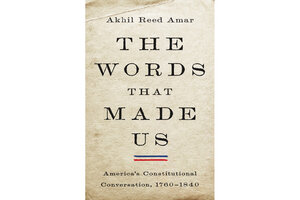America was built with pamphlets, not muskets
In his compelling new book, “The Words That Made Us," Akhil Reed Amar traces how early Americans wrote – and rewrote – the country into existence.

"The Words That Made Us: America’s Constitutional Conversation, 1760-1840" by Akhil Reed Amar, Basic Books, 832 pp.
Basic Books
Who wrote the Declaration of Independence? Thomas Jefferson is generally credited as its author, but Akhil Reed Amar believes there’s a better answer. “America did,” Amar argues in “The Words That Made Us: America’s Constitutional Conversation, 1760-1840.”
Amar’s fresh and fascinating history focuses on the explosion of impassioned discourse that culminated in, and followed, the ratification of the U.S. Constitution. The book elevates the importance of dialogue and debate in cementing American identity. Of the declaration, for instance, the author observes that it “undoubtedly was a tool to win the war – an instrument in one sense no different from a musket or a ship.” Unlike the weaponry of the American Revolution, however, the Declaration of Independence “aimed to win a war by winning men’s minds – by reason and rhetoric, by persuasion, by conversation of a certain sort. Muskets and ships cannot do this.”
Amar covers familiar events in the run-up to the Revolution, including Colonial resistance to the 1764 Sugar Act and the 1765 Stamp Act. But he begins his narrative with a less well-known episode, tracing the ideological origins of the war to Paxton’s Case. In this intricate 1761 Massachusetts lawsuit, lawyer James Otis Jr., representing a group of Boston merchants, argued that writs of assistance – orders that allowed provincial customs officers to search Colonial property for smuggled goods – violated colonists’ rights.
The writs case paved the way for the argument that the British Parliament did not have legitimate authority over the colonists, who lacked parliamentary representation. At this time, Amar points out, the individual Colonies were more in touch with the mother country than with one another. As they continued to bristle at British rule, however, “colonists were increasingly in conversation with each other and in the process were increasingly becoming Americans.”
These conversations were both deep and wide. Colonial assemblies began to correspond with each other for the first time, while newspapers, books, broadsides, and political cartoons proliferated. (By the 1790s, America had more newspapers per capita than any other country, Amar reports.) Thomas Paine’s 1776
pro-independence pamphlet “Common Sense,” read and reprinted widely, had a transformative effect. “Almost overnight,” the author writes, it “upended colonists’ emotions about their king and revolutionized their attitudes about kingship in general.”
Amar emphasizes the accretive and reciprocal nature of the political discourse. As the Colonies broke from Britain, they drafted their own state constitutions, building on ideas their neighbor states were developing. The framers of the U.S. Constitution, meeting in Philadelphia in 1787 to replace the ineffectual Articles of Confederation, borrowed from and improved upon the states’ ideas. In turn, after the U.S. Constitution was ratified – a process that itself involved a year of heated continent-wide conversation at state ratifying conventions – the state constitutions began to incorporate features of the federal model.
“The Words That Made Us” is particularly timely. Amar writes, “The most important conversational imperative in the early republic was the simple existential requirement that the Constitution ... survive.” Its survival wasn’t taken for granted then, and many have warned that its survival should not be taken for granted now.

